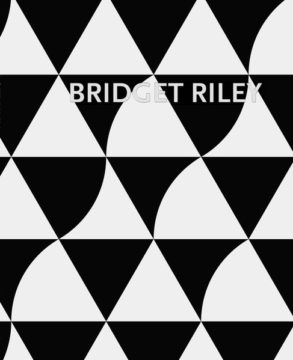Nachdem sie 2012 mit dem Rubenspreis der Stadt Siegen geehrt wurde, realisierte Bridget Riley zwei Jahre später ein zehn Meter breites Wandgemälde im Foyer des städtischen Museums für Gegenwartskunst. Es handelte sich um ein rein schwarzweißes Bild, aufgebaut aus schwarzen Winkelformen auf weißem Grund. Nach Jahrzehnten intensiver Beschäftigung mit Farbe schloss die Künstlerin damit an ihr frühes Werk als Pionierin der Op art Anfang der 1960er Jahre an. In der Galerie Max Hetzler in Paris zeigt sie dann 2015 eine konzentrierte Auswahl von fünf verwandten Arbeiten: ein knapp neun Meter breites Wandgemälde, sowie zwei monumentale und zwei kleinere Tafelbilder. Alle sind konsequent schwarzweiß und variieren das Motiv der abgewandelten Dreiecksform mit einer konkav oder konvex gerundeten Seite. Die beiden kleineren Bilder sind selbst Dreiecke. Die unterschiedlichen Größen im Raum verleihen den Bildern und wiederholenden Formen eine komplexe Wechselwirkung. Das Buch macht hierbei die Entwicklungen und Bezüge der Werke untereinander so deutlich wie ein Gang durch die Ausstellung. Dazu stellt der französische Kunsthistoriker Éric de Chassey in seinem Essay Genese und Bedeutung dieser neuen Phase in einen Werkzusammenhang mit Gemälden aus früheren Schaffensphasen der Künstlerin.
UNBOUND CERTAINTIES
(Auszug aus dem Essay von Éric de Chassey)
… In thus revisiting her own past, Riley does not forsake her allegiance to the principles of modernism, which entails that each work of art is an adventure with an unforeseeable result reached through a process of trial and error, and not the illustration of a pre-existing idea or the mere formalisation of a floating image. Riley simply leaves aside – as she has long since done – the teleology that went with modernism up until the 1970s, in order to direct the viewers’ attention to the particular effects created by each painting.
The scale of the new paintings makes them not only a visual experience, but a bodily experience, too. Far from inducing the ‘radical disembodiment’ associated with Riley’s 1960s works, these paintings have their roots in the here and now of a bodily perception that can only function in the presence of a stable object. We identify an image on the surface of the painting at the same time as the image’s complex perceptual effects make themselves felt, whether or not we are conscious of them, concentrating on them or simply looking while paying no particular attention. But unlike the large curve paintings, where ‘one is unavoidably reminded of human gestures and movements’, the new black-and-white paintings are thoroughly non-figurative, without any suggestion of bodies: they are to be experienced by an incarnated eyesight, which is not replicated nor even hinted at in them. They are more like landscapes, or rather, because they are reduced to a contrast of black and white, they are like the movements of light and shadows that you can experience on a stable surface or moving across a field. Although this field is that of a picture or wall, it relates to experiences made in nature: ‘It did begin in Cornwall with walks on the cliffs’, Riley has acknowledged. ‘You walk one way and you walk back and the light is different.’ This is where the address of these paintings rests – not on the basis of a teleological notion of progress to which viewers would be led indiscriminately through excitation – but on that of a one-on-one relationship. What we experience first in these paintings are some harmonious certainties (and our uncertain world demands some certainties because we are lost enough in our everyday lives), which never lock themselves onto closed identities, but, within a prolonged viewing, are at our disposal to be freely and pleasurably analysed, broken apart, recomposed, started anew – each time in a personal way.
- Veröffentlicht am Donnerstag 27. März 2025 von Holzwarth Publications
- ISBN: 9783935567817
- 38 Seiten
- Genre: Hardcover, Kunst, Softcover
